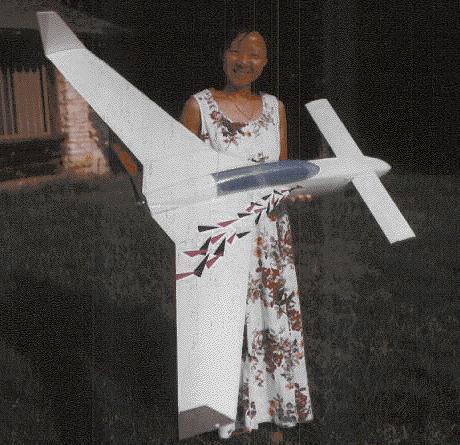
Minnesota Area R/C Electric Flight Enthusiasts (MARCEE)
The Hobby Lobby Vari-Eze
(Or how to be a little different at the field)
By Patrick Taggart
Cedar Park, TX

Vari-Eze ready to fly with Pat's Wife Mimi!
Background:
At the local flying fields I have acquired a reputation for the person most likely to bring strange looking things to fly.
It started with my first electric aircraft a Graupner Partenavia. As many oohs and ahs as this airplane generated, it was nothing compared to the reaction that greeted my Piaggio Avanti (Twin Pusher Canard!), my Cessna Skymaster, the Kyosho electric T-33 ducted fan and now the Hobby Lobby Vari-Eze.
The Vari-Eze is a relative newcomer, arriving from the Czech Republic, where many electric scale planes are being manufactured these days. As you know, it is a scale model of Burt Rutan's now classic home built, a rear engine push with canard swept-back wings and winglets. It is a remarkable aircraft in both looks and performance.
With my penchant for the weird I could not pass it up. The kit arrived complete: gel-coated fiberglass fuse with integral wing center section, obeche-covered wings and balsa canard, control surfaces and winglets.
Construction and Modifications:
The construction is straightforward and not at all difficult, but be warned that the translated instructions amount to so much gibberish. An experienced builder will have little problem as long as they refers to the parts list and studies the drawings.
To save weight I finished mine much as it appears on the box. Left the white fuselage unpainted; covered the wings, control surfaces, canard and winglets with white Oracover, which is the same as Goldberg Ultracote.
One modification I consider a necessity. The plans call for a fixed nose wheel. It takes very little enterprise to rig up a steerable gear. I used a Goldberg 3/32 strut mounted on the bulkhead provided, and simply mounted a Hitec HS-80 to the fuselage floor with a short push rod.
As is the current fashion, aileron control comes from one micro servo in each wing panel and provides good, direct, slop free control. I also used an HS-80 for the elevator.
Power:
I look around and found an unused Astroflight 15G. I realized that since I was going to have in in a pusher configuration all I had to do was remove the gear box, pinion and put on a prop adapter. The timing and rotation was already set for use with a conventional rotation prop.
Flying:
For my first flight - and I really can not remember why I did this - I used an 8-Cell pack. This is well below the Astro 15's maximum cell count. None the less, the airplane lifted up and flew well. Later I changed to a 10 cell pack and the performance increased dramatically. With this setup grass field take offs are entirely possible.
Wanting to experiment with the Kyosho Magnetic Mayhem Motor, with which I had no prior experience, I installed a Magnetic Mayhem Reverse, 8X4 pusher prop and a 7 cell pack. Believe it or not this combination gives very fine performance. (Did convert the MM to ball bearings, see conversion article on this web site MM Ball Bearing Conversion).
The Airplane flies much like any other with two exceptions. It doesn't really like to go into a loop, at least not with me at the sticks. Perhaps the canard needs to be a little bigger. The other quirk is shared with my other canard airplane, which is a tendency to porpoise severely on landing. I found that by completely releasing up elevator at the moment the nose wheel touches diminishes this tendency somewhat. I still don not know both of my canard airplanes do this. if anyone knows, please Email me at chopin3@ix.netcom.com
In short I am quite happy with this unusual aircraft. I will say that at a price of $259, it can never be considered a bargain.
Pat Taggart chopin3@ix.netcom.com